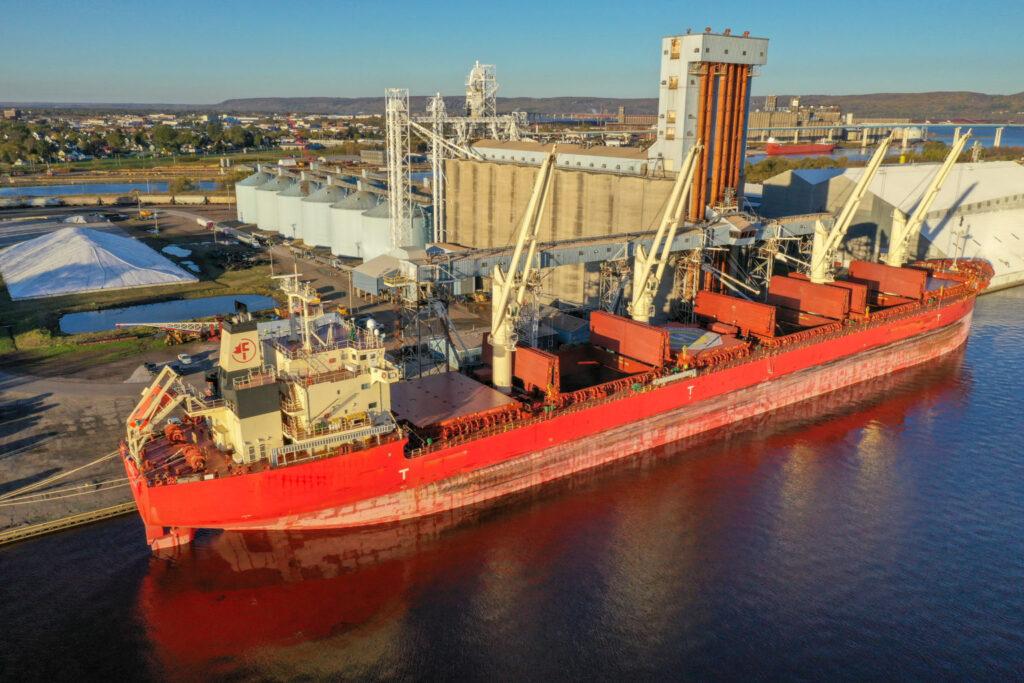
Great Lakes-St. Lawrence Seaway expected to be bustling this spring with vessels full of grain for export
The Great Lakes-St. Lawrence Seaway will be bustling this spring with large volumes of wintered grain being shipped to markets as global demand is anticipated to remain strong throughout 2021.
Spurred by the higher pricing caused in good part by pandemic stockpiling, farmers are also expected to increase Canada’s overall export crop by one to three million metric tons if the weather cooperates.
“We see producers seeding as many acres as they can and really ramping up the amount of grain that is available,” shares Jean Marc Ruest, Senior Vice-President, Corporate Affairs and General Counsel at major grain handler Richardson International. “How much will go through the Great Lakes-St. Lawrence system as opposed to other coasts will depend on pricing, and where the international demand is. But, all things point to an optimistic season.”
Seaway grain shipments up 27% in 2020
The Great Lakes-Seaway network had proven its readiness to handle larger grain volumes even in pandemic circumstances. Inland shipping buoyed last year’s challenged economies in Canada and the U.S. with record grain handled by the system.
Larger harvests and strong overseas demand increased the Seaway’s grain volume by 27% over 2019, significantly offsetting the decline in other cargo.

The second largest Prairie harvest on record contributed to 11 million metric tons of Canadian grain being shipped through the Seaway – up from 8.8 million metric tons in 2019 for a 26.5% increase.
U.S. grain shipments increased by 29% to 2.1 million metric tons, compared to 1.66 million metric tons in 2019 when extensive flooding suppressed planting. Newly purchased or reassigned grain cars, along with the Seaway structure’s 99.6% availability, facilitated smooth crop movement, despite the required COVID-19 precautions.
The St. Lawrence Seaway Bi-national Pandemic Unified Command Centre was established, adapting earlier SARS and H1N1 safety protocols to current risks. The safety of ship-shore interactions were further ensured by the Chamber of Marine Commerce establishing the Marine Industry Trusted Partners program which helped align safety measures and opened the channels of communications between ship operators, pilots, ports and marine suppliers.
Hands-free mooring throughout the Seaway with the U.S. locks implementing the technology last year proved timely in minimizing contact. “While installed for safety reasons, it also improved transit times, potentially adding sailing days,” Bowles says.

Benefits of Welland Canal season extension
Seaway authorities received praise for keeping the Welland Canal open an extra week for a second year of a pilot project, as well as later taking advantage of milder weather to only close the system January 8.
The additional time helped ports like Thunder Bay to have its best year since 1997. The port handled 9.2 million metric tons of grain, up 1.3 million metric tons from 2019. While more grain moved East, another major factor was the abundance of Manitoba canola and soybeans.
“With its larger, more diversified harvests, Manitoba outpaced Saskatchewan in terms of shipments to our port for the first time,” notes Tim Heney, the port’s CEO. “The strong, particularly European demand for canola and soybeans kept domestic ships busy, but also had more than 150 foreign vessels calling on our port – the second highest number since the Seaway’s opening.
“In some cases, they carried 22,000 million metric tons down the Seaway and topped up to 35,000 metric tons from lakers at the Port of Quebec before heading to Europe, North Africa or the Middle East,” Heney adds.
New grain infrastructure in Ontario
The bumper year definitely led to more grain business at the now networked ports of Hamilton and Oshawa. Recent investments to bolster capacity facilitated the ports handling 2.57 million metric tons (including soybeans) in 2020.
“That’s 37% higher than in 2019,” notes Ian Hamilton, the Hamilton-Oshawa Port Authority’s president/CEO. The longer season permitted seven additional vessels, each with 25,000 to 30,000 metric tons of steelmaking commodities, wheat and canola, to get through the system. “In that one extra week, those vessels replaced up to 6,700 trucks, reducing the carbon footprint of those goods by 500%,” Hamilton notes.
Oshawa handled a record 82,000 million metric tons of grain with a brand-new facility loading six vessels. “Constructed by QSL for Sollio Agriculture, this facility completed its first full season, for the first time allowing some 200 Durham region farmers to deliver soybeans, wheat and corn to an export facility within their own region, rather than trucking often clear across the Greater Toronto Hamilton area,” Hamilton says.
Canada definitely benefitted from overseas stockpiling of domestic food supplies. “Advanced ordering was deemed necessary to reduce price pressures in Asia – particularly China, but also places like Pakistan – as concerns mounted about possible shortages,” explains Andrea Gardella, EDC’s senior economist.
Doubling of wheat shipments to China
As a result Canadian wheat shipments to China doubled, and substantially increased to other markets with a lot more people at home eating pasta or baking muffins and bread. “We expect this trend to continue with export demand already high this year,” Gardella adds.
In Quebec, the story is soybeans. China is the main purchaser as it rebuilds pork stocks after the 2018 swine flu. “By the end of October, Quebec’s soybean shipments were up 37%, boosting the province’s agri-food exports by 11%,” Gardella notes.
Staying in that game will be challenging but, even as a small player, Quebec has possible advantages. “Quebec harvests soybeans well ahead of Latin America and parts of the U.S.,” Gardella explains. Recent precipitation has ended the severe drought for Latin America’s major producers, but La Niña is expected to make the 2021 growing season drier than normal throughout Argentina, as well as Brazil’s northeast and southern regions.
“The recent rains will allow South American production to be a competitive factor,” emphasizes Bill Krueger, the president of the Andersons Trade Group, which transports wheat, oats and other agricultural crops and feed through the Port of Toledo.


U.S. grain movement recovered in 2020
U.S. grain movement has recovered from 2019’s spring flooding. In 2020 the Port of Toledo welcomed restored crops from Ohio, Michigan and Indiana, leading to 1.55 million tons being handled – the largest volume in five years.
“We’ve increased animal feed shipments – specifically distiller’s dried grains as a by-product of corn refined for ethanol, as well as corn gluten,” says Joe Cappel, Toledo-Lucas County Port Authority’s vice president of business development. “We’re also seeing marine transport used more often to move smaller volumes of various commodities on grocery boats.”
Making the most of shortsea shipping, the port receives basically all the soft Canadian wheat used by the Mondelez Flour Mill by freighter. The port also handled 400,000 tons of Canadian alfalfa, canola and oats via Thunder Bay as horse-feed. U.S. exports were also helped by the arrival of more foreign vessels. “They’re looking for something to take back – and that’s usually grain,” Cappel says. “A lot of corn and soybeans went overseas.”
Entering 2021, cautious optimism reigns at the Port of Duluth-Superior, the biggest U.S. maritime gateway on the Great Lakes. “The Upper Midwest had good 2020 harvest conditions,” explains Jayson Hron, the Duluth Seaway Port Authority’s communications/marketing director. “Last November, however, EU tariffs were placed on U.S. cereal grains that will impact our exports.”
And it remains too early, Hron adds, to determine how the new White House administration might influence trade patterns.